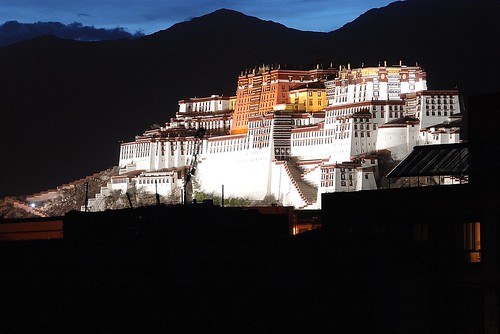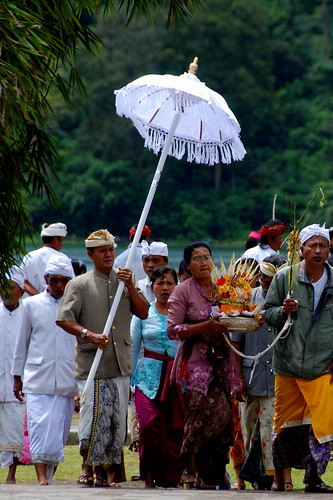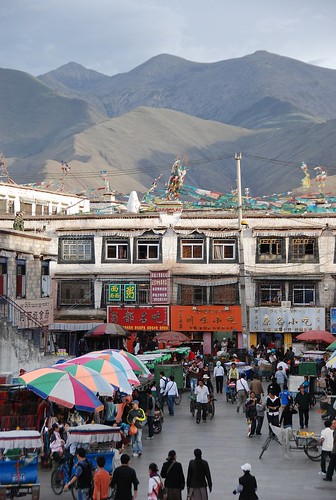The question came to mind while we joined hundreds of prayer wheel-swinging Buddhist pilgrims in circumnavigation around the Jokhang Temple. It also came to mind standing at the foot of Mt. Everest ... and when seeing military patrols cut through the streets and back lanes of Lhasa.
What really defines a place?
Is it history? People? Its politics and religion? How about its customs and culture? Or its geography?
It only took the trip from Lhasa's airport to old town to understand that Tibet was not only extreme in each one of these dimensions, but took them all ... threw them in a blender with some yak butter ... and mixed them all together into something entirely new to me.
A visit to Tibet takes your understanding of the world and flips it on its side. Like rolling down a hill in a truck tire, its at once exhilarating and disorienting.

People who know me would agree that I generally keep a pretty even keel. This all ends when I step foot in a Chinese airport. People dart in every direction without reason or regard for others while I suppress the urge to slip sleeping pills into their green tea. Newton famously said that no two bodies can occupy the same space at the same time. The check in "line" for a China Eastern flight is basically a bunch of people trying to prove him wrong.
So it came as a pleasant surprise when we arrived in Lhasa to a scene of general order and relaxed people. Picture people moving calmly toward baggage claim as if they were walking underwater. Then it dawned on us ... what we were witnessing was not so much an improved, more considerate Chinese airport but rather an intense fear among Chinese travelers of altitude sickness.
Oh well. I will take the sight of people walking around as if they were on cracking ice over the chaos of the alternative any day.

The first things that strike you about Tibet is the cobalt blue sky, intense sun and mountains ... everywhere. The capital, Lhasa, sits at an altitude of 3,200 meters (or about 10,500 feet) and is surrounded by a rim of tan, treeless mountains. The city was quite starkly divided between the old town and the much more modern, "Chinese" side. The distinction was pretty clear ... the old town is made up of narrow lanes, old temples, and fruit vendors while the newer side of town was full of generic shop facades and karaoke bars. We were happy to find our hotel in the heart of the old town.
We spent our first couple days exploring the spiritual heart of Lhasa. The Jokhang Temple is the most revered structure in all of Tibet and was only a few steps from our hotel. Every day, hundreds of Buddhist pilgrims join in a kora (pilgrimage circuit) around the temple. Dozens of vendors line the the path that meanders through narrow streets filled with the smells of incense, yak butter and more unpleasant things. You can't help but get swept up in the procession around the temple ... we made a point of joining the kora a couple of times each day
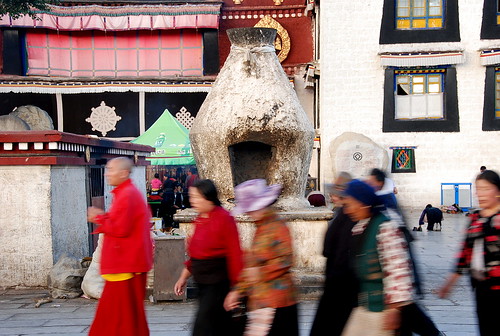

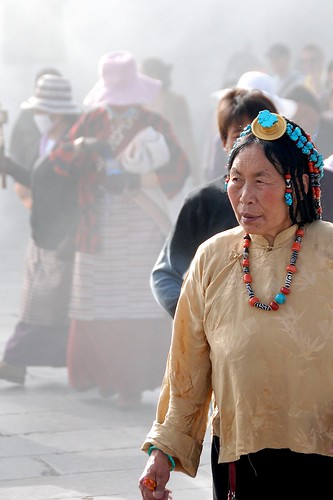
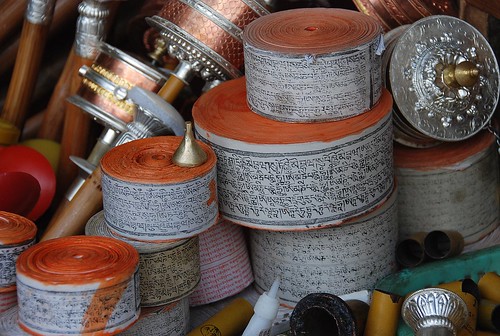
The Potala Palace is probably the most recognizable building in all of Tibet, and for good reason. Not only is it visible from most points in Lhasa but the structure is so imposing that it is hard to take your eyes from it. By our third day in Lhasa, we were acclimatized to the point where we were able to make the climb up its hundreds of steps. For a building that was home to the 5th to 14th Dalai Lamas and the center of its government, the palace today is merely an empty shell. Regardless, to climb its steps while imagining how it appeared during its time of prominence was an awe-inspiring experience. The views from the top were as breath-taking as the climb to get there

After three days in Lhasa, it was time to head west. Being that there were 11 of us traveling together, we hired a van and driver for the week. Upon seeing the green 20-passenger van for the first time, we affectionately named her "Jade Lightening". Stocked with snacks and people and on the lonesome road, we quickly realized that lightening probably wasn't the best choice in names. Had Miss Daisy been traveling with us, she would have told the driver to "pick it up!". The driver was no younger than 6o years old and he kept a stash of Red Bull in a box behind his seat. This was going to be interesting.
The Friendship Highway crosses Tibet from east to west and would be our main route for the next several days. We quickly gained altitude on our way out of Lhasa and enjoyed views over fields of yellow rapeseed to soaring mountains in the distance. From time to time we passed through small villages where the locals would always return our waves. Niko would throw candy out the window to the kids we passed.
The first day of driving took us over three high mountain passes ... each higher that the last and up to 5,000 meters (16,500 ft). We caught view of Yamdrok Tso (lake) from the pass over Kamba-la. The lake is an intense color of blue and is set among soaring mountain peaks. For Tibetans, it is one of the four holy lakes.
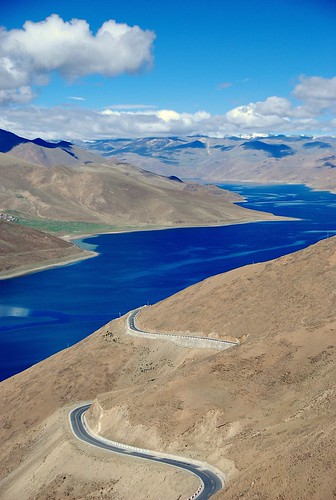
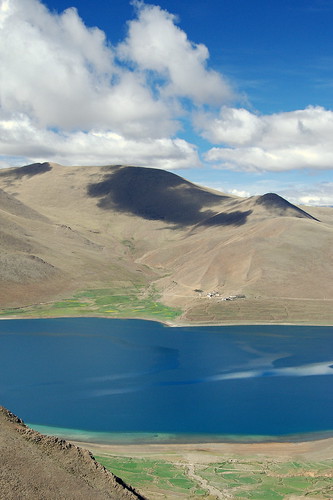
Our destination for the night was the town of Gyantse. What was formerly a center of trade in the region up to the 15th century is now a village of 15,000. Signs of its former prominence make the town an attraction today. The Pelkor Chode Monastery is quite active and is surrounded by tall hills topped by an ancient red wall. A cliff-hanging 14th century fort stands tall over the middle of town.

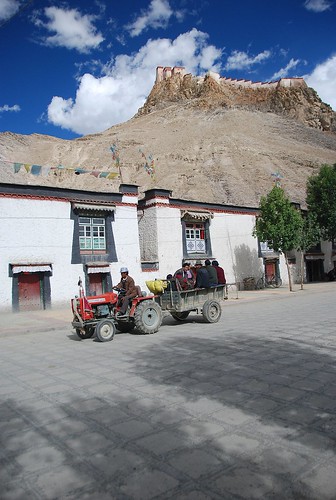
We explored the monastery and later wandered through the outdoor market in town. For 1 yuan (15 cents) per game, we played snooker in the market. It was quite a sight for the young kids hanging around. Everywhere we traveled in Tibet, kids were quite happy and quick to smile. We taught the market kids how to limbo under our outstretched pool sticks.

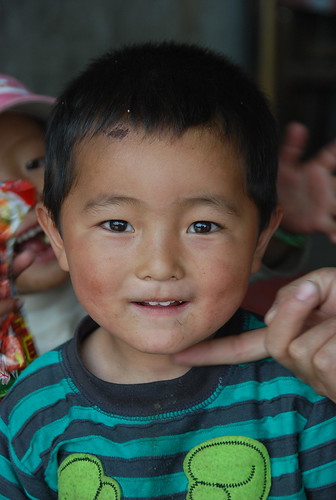
Like most days at such high altitudes, our energy waned quickly and we were asleep early. The next morning, we were up early and on the road heading west again. The city of Shigatse is the second largest in Tibet and the nearest jump-off point for the Everest region of the Himalayas. The town itself lacked any real character but the real attraction in the area is Tashilhunpo Monastery. Founded in the mid-15th century, the monastery was one of the few in Tibet to survive the Cultural Revolution. It is best known as the traditional home to Panchen ('great scholar') Lamas and is the most active monastery in Tibet. We spent a couple of hours merely wandering the narrow, cobbled lanes through the sprawling complex. The afternoon call to prayer brought the monks together in the assembly hall. We stood among them as they began to sing.
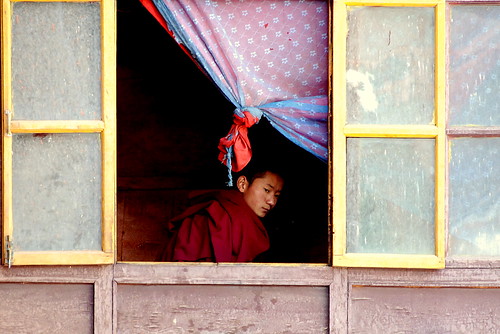
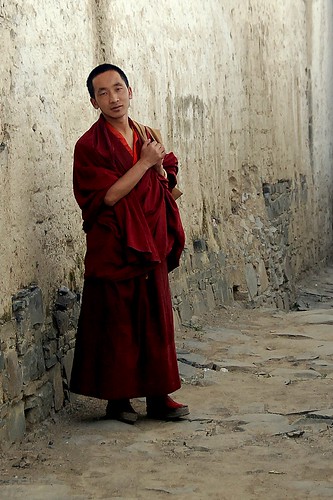
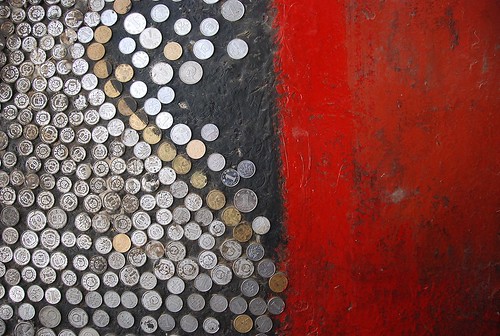
We up again early the next morning to start the long trip to the foot of Mt. Everest ...
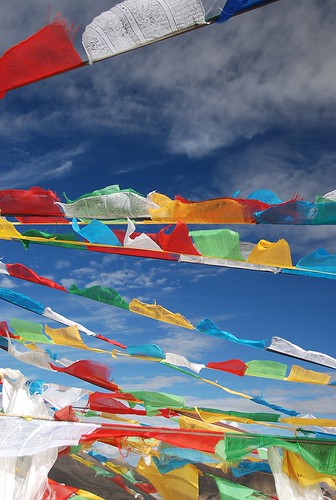
The trip from Shigatse to the tent camp at the base of Mt. Everest took 12 hours ... 4 of which were over rough roads & switchbacks. Jade Lightening was huffing and puffing her way along with us staring in awe out her windows. With each climb over another pass we would spot a snow covered peak off in the distance and say "that must be it!" ... but it never was ... Jade Lightening would chug along up another pass or around another narrow ridge
We finally approached the end of the road at the end of the afternoon as the rain clouds filled the sky. We pulled into an open area the size of a football field and parked the van along a row of boxy tents. It was frustrating to arrive at the foot of Everest and not be able to see the mountain, though we held out hope for morning.

Tent camp sat at just over 5,000m (16,500 ft) and we felt every bit of it. Walking off on flat ground to find a rock 'toilet' left us stopping to catch our breath.
The tents had a square footprint, with sitting surface around the inside edge of the perimeter. This would be our bed for the night. Each tent had room for four people, so we had three tents between us. We gathered in one tent around the yak dung-fired stove as light rain began to fall. Our host prepared garlic soup for us, which was said to help us with the altitude.
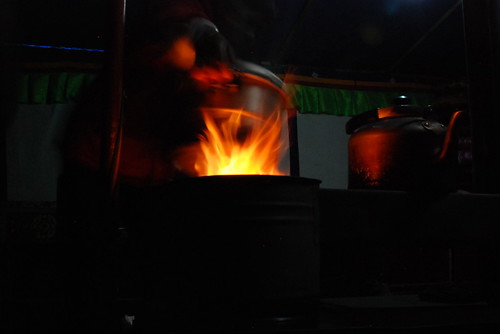
As night approached, the temperature began to fall toward freezing. We layered up with jackets and hats and made beds with blankets our hosts provided. The stove in our tent was fired up one last time but lasted no more than an hour. We all struggled with the altitude to some degree but tried to catch any sleep that we could. Morning would come early, as we planned to be on the trail to Base Camp before sunrise. Not long after we had all drifted off, three men carrying flashlights barged into our tent saying something we couldn't understand. Our only response was to yell "no!" and point outside. The best we could tell, they were looking for a tent with room for more people. It was hard enough trying to sleep at altitude without strange men interrupting it. It was a long night to be sure and one I will never forget. It has always been a dream of mine to see Mt. Everest in person. So as I lay in the tent trying to ignore my pounding headache, I thought about the day ahead and listened to the silence of the Himalayas.
The hike from tent camp to base camp covers 3km (2mi) with an elevation gain of 200m. Between the time, elevation, stomach ailments, temperature, lack of sleep and lack of breakfast, the 3km hike felt like we were truly going for the summit. We were on the trail at 6:00 and well before the sun was up. We could already tell, though, that the previous night's rain had helped clear the sky. As we started up the trail, we began to see the outline of Everest take form out of the darkness.

To see Everest in front of me was truly a surreal and amazing experience. Visions of legends like Hillary and Sherpa Tenzing Norgay flashed in my memory ... it was as if I could see moments in the climbing history play out before my eyes. On our calm morning hike to base camp, I could still picture the storms that whipped the mountain in May 1996 when Rob Hall and others perished near the summit.
Everything was quiet on the mountain when we arrived at Base Camp. The peak of climbing season had passed two months before, so the site was simply a bare flat area dotted with rock cairns built to memorialize fallen climbers. We could picture how the site must look at the height of climbing season. The morning clouds had almost completely burned off as the sun lit the sky.
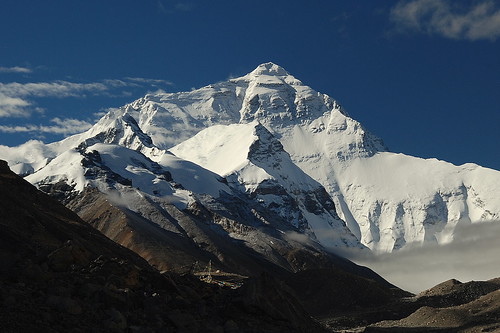

The clear views of the mountain lasted after we had returned to tent camp. Apparently, many visitors will come to Everest for an entire week and do not have the clear views of the mountain that we had. We all left on a high as we began our return trip to Lhasa via Shigatse.

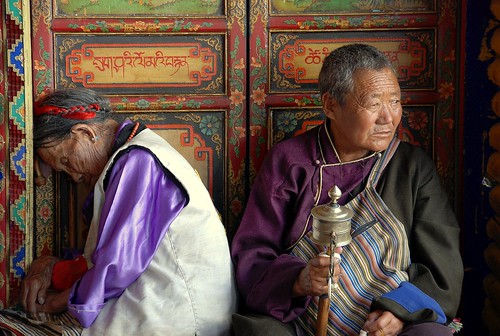
Compared to the thin air of Everest, we almost needed a spoon to take in that thick Lhasa air. We had a only a couple days left in the city and we were determined to make the most of them. Dirk and I got up before dawn on the first morning to explore the old town and watch the city come to life. Kids walked to school, butchers opened shop and pilgrims gravitated toward Jokhang Temple.
The afternoon was spent relaxing and exploring the markets. Lhasa is a great town for wandering. Narrow alleyways splinter out from the central square and they are filled with interesting people and activity. If you get turned around, all you have to do is find some pilgrims swinging prayer wheels and they will inevitably lead you back to the Barkhor.
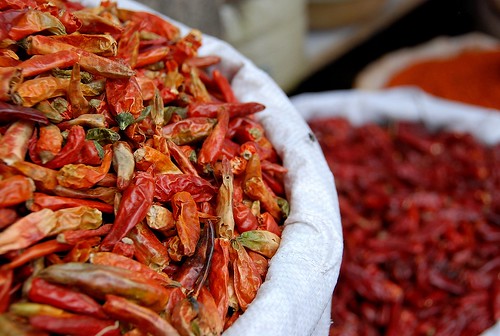
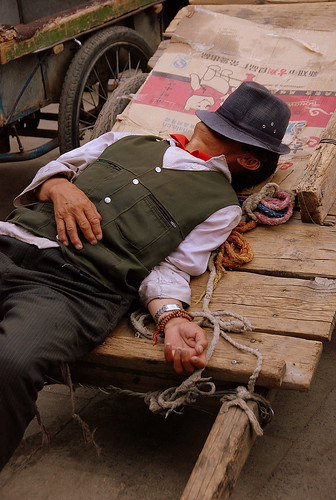
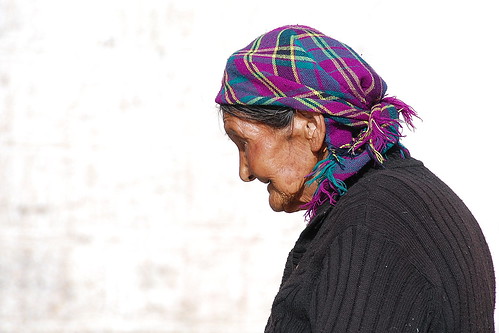
Our dance-off with the Tibetan kids started in the most innocent of ways. Walking through an alley, we stopped to say "hi" to a group of children that were playing after school. As we continued on our way, one of them playfully pushed Niko and, when he turned, showed him some of his home-grown break dance moves. Niko "got served" and the dance-off was on. The kids were good and had obviously been working on their moves with the help of bootleg American movies.

We countered any way we could. We came at them with the "Roger Rabbit" ...

... the tango ...

... and the Waltz.

The kids were tough and we quickly emptied our limited repertoire. So we graciously conceded defeat and waved our goodbyes.
We were almost back to the square when a few of the kids caught up with us and made it clear they were not quite through with us yet. They wanted a Barkhor Square dance-off and they would not take "bu yao" for an answer. They grabbed Dirk and pulled him off to the square. We had no choice but to follow.
I have to mention here that having a dance-off with a group of Tibetan kids in Lhasa's main square and in front of the holiest Temple in all of Tibet is not something that we had on our itinerary.
But the challenge was on and we couldn't back out now. Rule one in a fight (so I have read) is to always leave something in reserve. With that, Dirk came out strong with his best Michael Jackson (RIP) impression ...
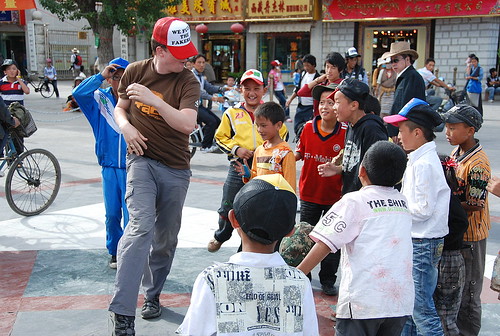
We were quickly reminded that nothing attracts a crowd in Tibet like a crowd.
Especially a crowd of local kids cheering on a Dutch guy doing a Michael Jackson impression in Barkhor Square.

I should also point out that the Chinese military in Tibet are not big fans of crowds forming in Barkhor Square. The crowd quickly got very big and the military patrols in the area started converging on the crowd. Niko saw the opportunity and took advantage of his last chance to wow the crowd. He jumped into the middle of the circle and gave them his best "party boy" dance. He had his 20 seconds to do his thing before the patrols broke up the crowd.

After a full day of walking and dancing, we were quickly running out of time in Tibet. We had one day left and time for one last adventure...

It was our last day in Tibet, so we had to go out on a high note. A local outfitter offered a whitewater rafting trip that would take us an hour outside of Lhasa to the Holung Chu River, so off we went. The river was swollen with rain water collected from the surrounding mountains and topped off with some glacial run-off. It moved at a pretty good clip and was cold enough that we had to wear wet suits. We spent several hours padding through whitewater, sailing past grazing yaks and gliding through canyons sliced through the ancient Himalaya. We took turns kayaking and, at the end of the afternoon, a few of us jumped in the river for an icy swim.



(Rafting photos taken by a local photographer affiliated with the rafting company)
It really was a fitting end to a great trip. It left us completely exhausted but we wouldn't have wanted it any other way ... short of breath is how it is on the rooftop of the world!
It was sad to say goodbye to our travel parters ... some of which we just met for the first time. We all traveled together really well, which was good since we were stuck in the same van together for hours and hours. It was also a really great experience for Harmony and I to travel with her brother Niko. In what seems like no time at all, he has gone from an ankle grabbing toddler to a really great guy with a bright future ahead of him.


It certainly wouldn't be a trip report of mine without mention of the food. So what of it? We were pleasantly surprised with how good the food was. Yak meat was a staple of our diet and was quite good ... picture a slightly tougher version of beef. A popular dish was yak momos, which were basically yak meat-filled dumplings. Food quality on the road was mediocre at best and few of us avoided the random stomach bug.

The question that came to my mind throughout the trip was no easier to answer as we departed Lhasa as it was when we first arrived.
Tibet is a truly unique corner of this world, but one in the midst of great transition (willed or not). Its people boldly face an uncertain future though its its economy is soaring. Its culture is anchored in deep-rooted traditions though the arrival of modern city life and new arrivals from east threaten to erode it.
What really defines a place?
I don't think I know the answer, but I will keep on doing my research
